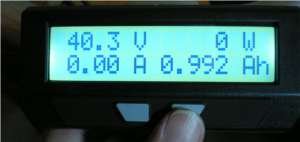Here's a closer look at the first mile of this 3 Wh/mile, 4+ mile trip ( the whole thing at http://www.ebikes.ca/tools/trip-analyzer.html?trip=C31wco ) on the Grin Tech Trip Analyzer page
You can see the bike is doing a bit less work than I am by eyeballing the area under the "HWatts" ("Human Watts") Green curve versus the (electrical, motor) Watts curve ( Blue curve ). Both of us stay under about 50 Watts except when starting up from a stop, and there the motor outpowers me

.

If you visit the link above, section off a snall amount of the trip where a section starts from zero MPH (put the X-axis in "Time"; without that no data show where the bike is stopped - as no mileage advances

). It's possible to see how I've set the PAS not to kick in until 6MPH.
I have noticed that even in my hot Southern Calif mornings (80+ degrees) I don't break a sweat on a 4+ mile commute like this -- for me that means keeping my average Human Watts below 50 -- the NuVinci helps a lot with that; I can keep my cadence and torque constant and let both the bike speed and PAS power just arrive at whatever speed and power air resistance, road slope, tire friction, other aspects of bike engineering and physics allow. It doesn't end up being fast.
Clearly both the motor and rider put the most power into acceleartion -- but that doesn't take a lot of the total mileage or time of the trip, so the Wh/Mile seems more dependent on how low the power goes just to maintain speed. This bike seems quite efficient at that on my flat-landed commute; we both keep it under 50 Watts and neither of us breaks a sweat

.
If I switched the assist level from its present 48% of power to 99%, I'd expect the Wh/Mile to double to about 6 Wh/mile

.





